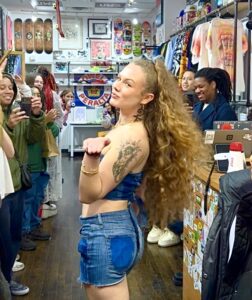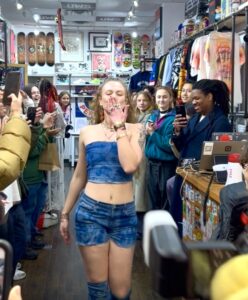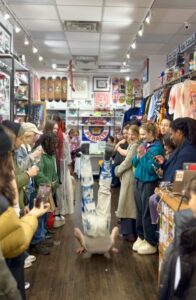American fashion designer Betsy Johnson is known for her cartwheels ending with splits on the catwalk — something that Olive Louise Jenkins is not far from achieving as well.

Olive Louise Jenkins is a fashion designer and student by day, and circus member by night. The 22-year-old is promoting and growing their clothing brand, 2theFuture, in New York City, all while pursuing their anthropology major at Columbia University, participating in their school’s circus club, and practicing cartwheeling in their free time. 2thefuture features colorful sweatsuits with faces and bodies drawn and stamped on them, inspired by Jenkins’ love for people, their family’s artwork, and the culmination of art projects they’ve done over the years.
I met up with Jenkins at the Shade Bar on a chilly Thursday afternoon in NoHo. They still had that long curly blond hair, urban-grungy-looking fashion sense, and confident strut I remember them having back when they were a kid. Jenkins was my neighbor in the Chicago South Loop back in the 2000’s, living just a building down from mine. They were a cool-looking kid on the block with their exotic style and crazy hair that drew me to them.
I got to know what a fun personality they had in Chicago, and a sense of doing their own thing, being unabashedly themself. I found pictures of them posing at our local neighborhood summer fair, in our childhood days, with a bright pink scarf and funky glasses, sticking out their tongue and throwing up a rock sign.
Jenkins stood a height of 5’10 — evident next to my 5’4 — making them hard to miss among their other traits. They welcomed me in the bar with open arms and a genuine smile, eager to catch up with me and start the interview.
It was wintertime, and Jenkins was finishing up their last semester at Columbia University. After graduation, Jenkins plans to pursue their fashion line full-time. They are making it in New York City, bringing their Chicago roots to the brand.
2thefuture is an urban, grungy, hip style brand that comprises mostly of sweatsuits (sets of sweatpants and sweatshirts), tops, and jeans that Jenkins started during the pandemic. Jenkins started creating some clothes for a friend, Doso, before starting the brand. They then thought it looked good and started making their own clothes, doing pop-up shows and runways ever since. As an artist in different avenues, whether it be photography, modeling, or drawing, they gain creativity from their past projects. “The brand was a natural culmination of the different arts stuff I was already doing,” Jenkins said.
At the bar, Jenkins came with their portfolio style notebook, which they always carry with them, with scribbles and countless lists of ideas and drawings of clothing items they have in mind to design.
“If I ever am trying to find motivation for myself, I tend to look over old work or brainstormed ideas that I have,” Jenkins said. “It’s to remind myself of things that were once an idea, and how they are now tangible pieces — which is so exciting to me.”
Jenkins says the term “2 the future” was a way to think of their final products as a gift they send to their future self from the past, as a reminder that what is most important is the creation process itself as opposed to the final product.
“Don’t be afraid to create the art,” Jenkins said is their advice to other artists. “A lot of people have ideas. It’s just a matter of bringing them into the world.”
Jenkins also came up with the brand name from what they call their Instagram “alter-ego,” @Olivefromthefuture, which started as a joke among their friends: they would anticipate other people’s fashion trends before they became trends, thereby convincing people that Jenkins must be from the future.
And 2thefuture is exactly that: trendsetting. The pandemic triggered a 25% increase in the prevalence of anxiety and depression worldwide, according to a scientific brief released by the World Health Organization. Jenkins then created a sense of community that people desperately needed through fashion. The faces and bodies that were featured on Jenkin’s clothing items brought a sense of community to those who sported the outfits. Funky patterns, shapes, and colors, along with the use of leg and arm warmers made from jean and cotton fabric — and fringe — is what made the brand unique and different from the mainstream.
“It’s like I have all these little friends [in the images of people on clothing] around me when I am wearing my clothes,” Jenkins said. “It makes me so happy. Who wouldn’t want that?”

The inspiration behind the faces and bodies that Jenkins’ clothing features comes from their family. Their mother’s art lingers around the house, along with their grandmother’s, who drew pictures of women.
“I was definitely inspired by seeing some of my grandmother’s work,” Jenkins said. “Especially when she was younger.”
Jenkins’ mother, Noah, is equally inspired by her child’s work. Noah recalls Jenkins’ “wild sense of style” growing up that she has grown to appreciate over time.
In one memory, Noah remembers a time when Jenkins wore a pair of leggings that were so old that the knees were worn through, and Jenkins put them on with their legs going through the holes, creating capes for her calves.
“I was just mortified,” Noah said.
The eccentricity continued to Jenkins’ accessories, Noah remembers. “She spent a long-time pouring glitter on her hair,” Noah added. “That was part of getting up in the morning.”
Jenkins’ childhood friend, Zora Navarre, found beauty in Jenkins’ quirkiness. Navarre remembered a period of time the two of them would go to elementary school wearing pajamas.
“She was loud — but cool,” Navarre said. “She just did her own thing. In kindergarten, she was the cool pajama girl.”

Navarre and Jenkins were lucky enough to reconnect in college when they went to neighboring schools in the Upper West Side and were roommates throughout undergrad.
Her fashion “is fearlessly expressive,” Navarre can now say, watching Jenkins grow all these years. “It’s not a kind of mask that some people’s fashion is.”
“She was just the weird kid growing up,” added Brielle Hampton, Jenkins’ high school friend. “Then, suddenly, there’s this [new trend] that being weird was cool.”
Jenkins’ family loves to flaunt 2thefuture. “Both my boyfriend and I wear her stuff,” Noah said. “I wear the special workout clothes she made me. My boyfriend wears her hoodies — he is a Capitan of the Chicago Fire Department. When he shows up in those, he gets a lot of compliments.”
Jenkins also does not shy away from giving compliments, as it is in their kind nature, Noah points out.
“Ever since she was little, if she sees something she likes, she will stop and tell you,” Noah said. “It was cute when she was little — but I’ve observed that, as a young adult, when she stops a woman on the street and gives a compliment, people are really surprised. Women do not randomly give each other compliments.”
On a Friday evening, I met up with Jenkins again to watch their circus practice at the Columbia Circus Collective at Barnard Hall. Walking into the dimly lit room filled with six other circus members as well, they sat stretching, about to begin their free-form practice as I watched on the side. The leader of the group hit on her 2000’s playlist and the group of circus enthusiasts, of all levels, began getting into the groove of practice time. They started doing jumping jacks, planks, intense ab workouts, while I observed the shoes that stood right by me.

Jenkins shoes were their own graffiti-sprayed-sneakers that they designed among the rest of the other boring looking shoes.
When the practice started to include the circus movements, Jenkins was up to speed with the rest. They could hold a handstand, do the full splits, cartwheel their way around the area, and even hula hoop on one foot.
That got me thinking, maybe they could combine fashion and gymnastics, with cartwheels on the catwalk, and be the next Betsy Johnson — but in their own way.
“I’ve never tried doing cartwheels on the catwalk,” Jenkins said. “But that could be cool.”
 >
>